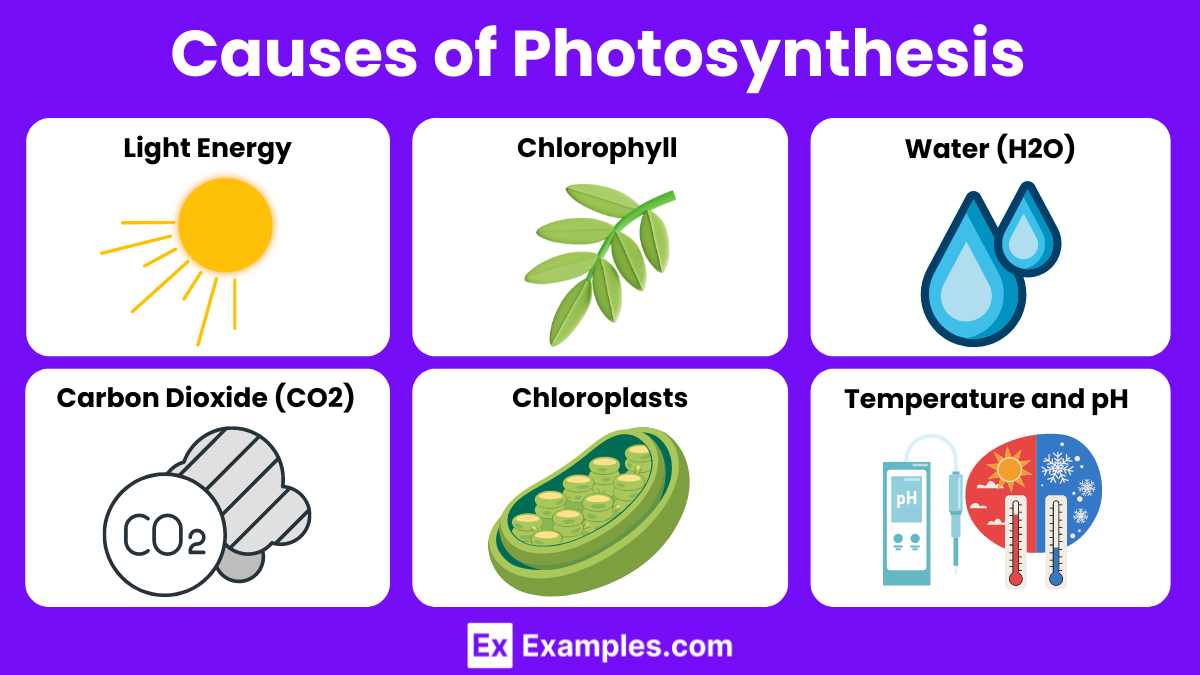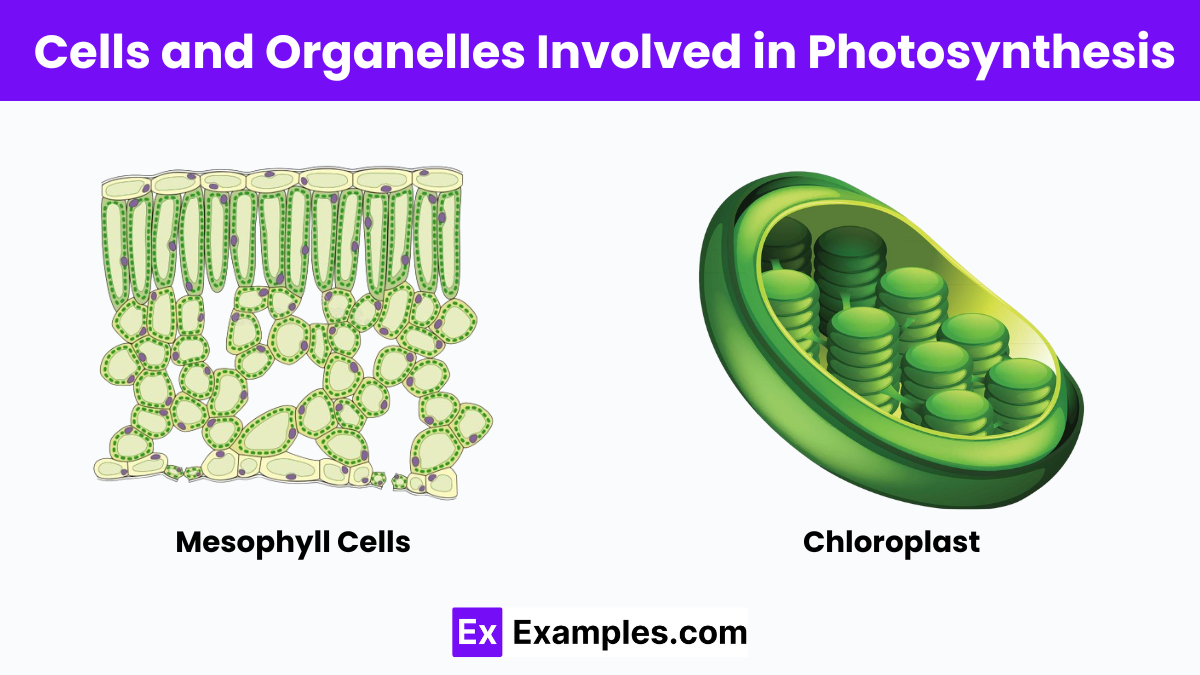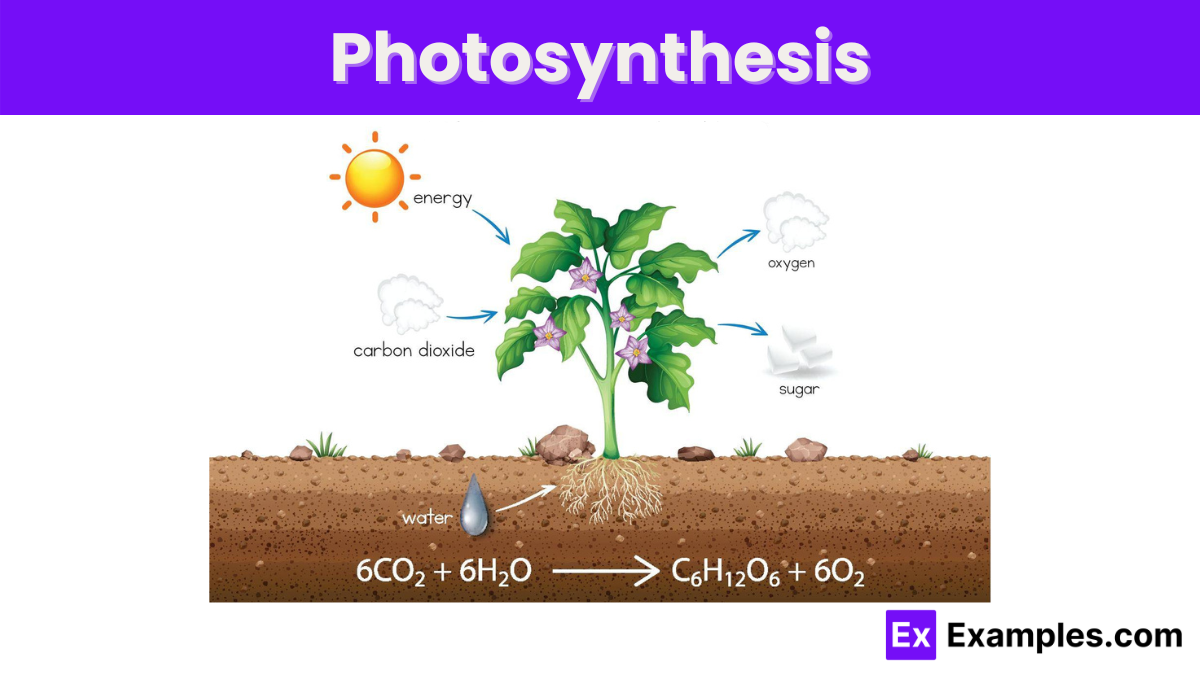Photosynthesis – Definition, Process, Equation, Causes & More
Photosynthesis is a vital biological process through which green plants, algae, and certain bacteria convert light energy into chemical energy. Using sunlight, these organisms transform carbon dioxide and water into glucose and oxygen, substances crucial for their growth and the sustenance of life on Earth. This process not only fuels the organisms themselves but also supports life on the planet by providing oxygen and forming the base of the food chain. Understanding photosynthesis is essential for comprehending how life thrives on Earth, influencing fields ranging from agriculture to energy production.
Definition of Photosynthesis
Photosynthesis is a fundamental biological process through which green plants, algae, and certain bacteria convert light energy into chemical energy. This transformation occurs primarily in the chloroplasts of plant cells where chlorophyll, the pigment responsible for the green color of plants, captures sunlight. The captured light energy is then used to synthesize glucose from carbon dioxide (CO2) and water (H2O), releasing oxygen (O2) as a byproduct. This process not only fuels the plant’s own cellular activities but also provides the base of the food chain for other organisms.
Where Does Photosynthesis Occur?
Photosynthesis primarily occurs in the leaves of plants, although it can also take place in any parts of a plant that contain green pigments, typically in the stems and young branches. The leaves are the main site of photosynthesis due to their structure and accessibility to sunlight.
Photosynthesis Process
Photosynthesis stands as a crucial biological process through which plants, algae, and certain bacteria convert sunlight into chemical energy, fueling their activities and growth. This process not only supports the organisms performing it but also sustains life on Earth by producing oxygen and forming the basis of the food chain.
Key Stages of Photosynthesis
Photosynthesis occurs primarily in two stages: the light-dependent reactions and the light-independent reactions (Calvin cycle).
Light-Dependent Reactions
These reactions take place in the thylakoid membranes of the chloroplasts. Here, sunlight drives the process, initiating the flow of electrons through a series of proteins known as the electron transport chain. Plants absorb sunlight using pigment molecules, with chlorophyll being the most prominent. This absorption energizes electrons, which the chloroplasts then use to convert water (H₂O) into oxygen (O₂). As a result, this stage releases oxygen as a byproduct and generates ATP and NADPH, energy carriers that the next stage of photosynthesis uses.
Location: Thylakoid Membranes
Within the chloroplasts, thylakoid membranes house the light-dependent reactions. These membranes are rich in pigments like chlorophyll that capture light energy, crucial for water photolysis and energy molecule production.
Steps in Light-Dependent Reactions
- Photon Absorption: When photons strike the chlorophyll in the photosystem II (PSII) complex, embedded in the thylakoid membrane, they excite electrons to a higher energy state.
- Water Splitting (Photolysis): To replace these excited electrons, enzymes split water molecules into oxygen, protons, and electrons. The process releases oxygen as a byproduct.
- Electron Transport Chain (ETC): The electrons travel down an electron transport chain, which comprises a series of proteins within the thylakoid membrane. The movement of electrons through the chain helps pump protons from the stroma into the thylakoid space, thereby creating a proton gradient.
- ATP Formation: This proton gradient enables ATP synthase to synthesize ATP from ADP and inorganic phosphate through chemiosmosis, as it uses the flow of protons back into the stroma.
- Photosystem I (PSI): Upon reaching PSI, the electrons get re-energized by more absorbed light. These re-energized electrons then reduce NADP+ to NADPH, which serves as a critical electron and hydrogen carrier in the Calvin cycle.
- Output of Light-Dependent Reactions: ATP and NADPH, produced during these reactions, enter the Calvin cycle to assist in carbon dioxide fixation into glucose. Meanwhile, the oxygen produced during water splitting exits as a waste product.
Significance of Light-Dependent Reactions
The light-dependent reactions are vital as they provide the necessary energy carriers (ATP and NADPH) for the Calvin cycle. They also maintain the oxygen level in the atmosphere, which is critical for the survival of aerobic life on Earth.
Calvin Cycle (Light-Independent Reactions)
The Calvin cycle unfolds in the stroma, the fluid-filled space surrounding the thylakoid membranes. It does not require light directly. Instead, it uses the ATP and NADPH from the light-dependent reactions to convert carbon dioxide (CO₂) from the air into organic molecules. During this cycle, the enzyme RuBisCO incorporates CO₂ into an organic molecule, starting a series of chemical reactions that regenerate the starting molecule with the production of glucose and other carbohydrates.
Key Steps of the Calvin Cycle
- Carbon Fixation: The cycle begins when the enzyme RuBisCO incorporates carbon dioxide into a five-carbon molecule, ribulose bisphosphate (RuBP). This reaction produces a six-carbon compound that immediately splits into two three-carbon molecules of 3-phosphoglycerate (3-PGA).
- Reduction Phase: Each molecule of 3-PGA then receives a phosphate group from ATP, becoming 1,3-bisphosphoglycerate. Next, NADPH donates electrons to these molecules, reducing them to glyceraldehyde-3-phosphate (G3P), a sugar. This step consumes the ATP and NADPH generated during the light-dependent reactions.
- Release of One Glucose Molecule: For every six molecules of CO2 that enter the cycle, twelve molecules of G3P form. However, only two G3P molecules leave the cycle to contribute towards forming glucose, while the remaining ten G3P molecules proceed to the next step.
- Regeneration of RuBP: The ten remaining G3P molecules undergo a series of transformations that require further ATP. These transformations regenerate RuBP, enabling the cycle to process new carbon dioxide molecules continuously.
Significance of the Calvin Cycle
The Calvin Cycle is crucial for synthesizing glucose, which plants use as an energy source to fuel various cellular activities and growth. The glucose also serves as a building block for other essential biomolecules such as cellulose and starch. Additionally, this cycle plays a pivotal role in the global carbon cycle, as it is the primary pathway through which atmospheric carbon dioxide transforms into organic compounds within plants.
Importance of Photosynthesis
Photosynthesis is vital for life on Earth. It provides the primary energy source for all ecosystems, where plants form the base of the food web and create biomass from inorganic substances. Moreover, photosynthesis is responsible for the oxygen that makes up a significant portion of the Earth’s atmosphere and supports aerobic life forms.
Photosynthesis Equation
The formula for photosynthesis is central to understanding how plants convert solar energy into chemical energy. Here is the equation:
6𝐶𝑂2+6𝐻2𝑂+𝑙𝑖𝑔ℎ𝑡𝑒𝑛𝑒𝑟𝑔𝑦→𝐶6𝐻12𝑂6+6𝑂26CO2+6H2O+lightenergy→C6H12O6+6O2
Explanation of the Photosynthesis Equation
This equation represents the overall process by which plants, algae, and certain bacteria produce glucose and oxygen from carbon dioxide and water, using energy from sunlight. Here’s a breakdown of each component:
Carbon Dioxide (6CO2)
Tiny pores in the leaves called stomata take carbon dioxide from the air. Carbon dioxide is one of the key reactants in the process.
Water (6H2O)
The roots absorb water and transport it to the leaves, providing the source of electrons and protons necessary for the chemical reactions of photosynthesis. Water molecules split to produce oxygen.
Light Energy
Chlorophyll and other pigments in the chloroplasts capture light energy, converting it into chemical energy in the form of ATP and NADPH. These energy carriers then power the later stages of photosynthesis.
Glucose (C6H12O6)
The plant uses the sugar produced by photosynthesis as an energy source. It can use this sugar immediately, store it, or convert it into other necessary substances for growth.
Oxygen (6O2)
Oxygen releases through the stomata as a byproduct, playing a critical role in the Earth’s atmosphere and supporting the survival of aerobic organisms.
Causes of Photosynthesis

Light Energy
Light energy, especially from the sun, triggers photosynthesis. Pigments in the plant, mainly chlorophyll, absorb mostly blue and red wavelengths of light, crucial for converting ADP and inorganic phosphate into ATP, and NADP+ into NADPH, which are used in glucose synthesis.
Chlorophyll and Other Pigments
Chlorophyll primarily absorbs light. Other pigments like carotenoids and phycobilins help capture energy from sunlight, absorbing light wavelengths that chlorophyll cannot. These pigments are critical in harnessing the light energy required to drive the reactions of photosynthesis.
Water (H2O)
Water acts as an electron donor in the light-dependent reactions of photosynthesis. The process of photolysis splits water molecules, releasing electrons, hydrogen ions, and oxygen. The reactions use the electrons and hydrogen ions to produce glucose, while plants release oxygen as a byproduct.
Carbon Dioxide (CO2)
The stomata in the leaves absorb CO2 from the atmosphere. It is a critical substrate in the Calvin cycle (light-independent reactions), where it fixes into glucose using the ATP and NADPH produced in the light-dependent reactions.
Enzymes
Various enzymes facilitate the chemical reactions involved in photosynthesis. For example, the enzyme Rubisco plays a pivotal role in fixing carbon dioxide during the Calvin cycle, converting it into glucose. Enzymes ensure that the photosynthetic reactions occur efficiently and at a sufficient rate to meet the plant’s needs.
Cellular Structures (Chloroplasts)
Chloroplasts, specialized organelles in plant and algal cells, house the biochemical machinery necessary for photosynthesis. The thylakoid membranes in chloroplasts provide a framework for light-dependent reactions, while the surrounding stroma hosts the Calvin cycle.
Temperature and pH
Temperature and pH levels also influence the rate of photosynthesis. The enzymatic reactions involved are sensitive to temperature and have optimal pH ranges. Deviations from these optimal conditions can slow down or inhibit the process.
What Cells and Organelles Are Involved in Photosynthesis?

Photosynthesis, a critical process through which green plants, algae, and some bacteria convert light energy into chemical energy, occurs largely in specialized cells and organelles designed to maximize the efficiency of light capture and conversion. The primary cells and organelles involved in photosynthesis are mesophyll cells, chloroplasts, and, more specifically, structures within the chloroplasts including the thylakoid membranes and stroma.
Mesophyll Cells
Mesophyll cells in plant leaves primarily conduct photosynthesis. These cells contain high concentrations of chloroplasts, the essential organelles where photosynthesis takes place. There are two types of mesophyll cells:
Palisade Mesophyll
These cells, located directly under the leaf surface, are elongated and densely packed with chloroplasts, primarily absorbing light and conducting photosynthesis.
Spongy Mesophyll
These cells, found below the palisade mesophyll, aid in gas exchange and also contain chloroplasts contributing to photosynthesis.
Chloroplasts
Chloroplasts are the key organelles where photosynthesis occurs. These double-membraned structures contain their own DNA and can replicate independently within the cell. Inside chloroplasts, two major stages of photosynthesis—the light-dependent reactions and the Calvin cycle—take place in different components:
Thylakoid Membranes
These membrane-bound structures, stacked into grana within chloroplasts, contain chlorophyll, essential for absorbing sunlight. The light-dependent reactions of photosynthesis occur here, converting sunlight into chemical energy in the form of ATP and NADPH.
Stroma
This fluid-filled space surrounds the thylakoid membranes inside the chloroplast. Here, the Calvin cycle, also known as the light-independent reactions, occurs. It uses the ATP and NADPH produced by the light-dependent reactions to convert carbon dioxide into glucose, serving as an energy storage molecule for the plant.
Importance of Each Component
Each part within the mesophyll cells and chloroplasts plays a crucial role in the process of photosynthesis:
- Mesophyll cells ensure that chloroplasts are in the optimal position to receive sunlight and facilitate gas exchange, which is vital for photosynthesis.
- Chloroplasts function as the site of the photosynthesis process, housing all the necessary molecular machinery.
- Thylakoid membranes are critical for capturing light and transforming it into usable energy.
- Stroma provides the enzymatic playground for synthesizing organic molecules from carbon dioxide and water.
Factors Influencing the Rate of Photosynthesis
1. Light Intensity
- Impact: The rate of photosynthesis typically increases as light intensity rises, up to a certain point. Beyond this point, the process plateaus as other factors become limiting.
- Explanation: Light provides the energy needed for photosynthesis. More light equates to more energy available to drive the chemical reactions involved.
2. Carbon Dioxide Concentration
- Impact: Increasing the concentration of carbon dioxide can enhance the rate of photosynthesis, until the process is constrained by another factor.
- Explanation: Carbon dioxide is a raw material used in the formation of glucose during photosynthesis. Higher concentrations can increase the rate of carbon fixation in the Calvin cycle.
3. Temperature
- Impact: Photosynthesis is temperature-dependent, with the rate increasing up to an optimal temperature and then rapidly decreasing at higher temperatures.
- Explanation: Enzymatic reactions that drive photosynthesis perform optimally within a certain temperature range. Too high or too low temperatures can denature these enzymes, reducing the efficiency of photosynthesis.
4. Water Availability
- Impact: Water stress can severely limit the rate of photosynthesis.
- Explanation: Water is not only a reactant in the chemical equation of photosynthesis but also essential for the plant’s overall health and turgidity. Lack of water can lead to stomatal closure to conserve water, thereby reducing CO2 uptake.
5. Quality of Light
- Impact: Different wavelengths of light affect photosynthesis differently. Blue and red lights are most effective in driving photosynthesis.
- Explanation: Chlorophyll, the primary pigment in photosynthesis, absorbs blue and red light more efficiently than other wavelengths.
6. Chlorophyll Content
- Impact: The amount of chlorophyll in leaves affects their ability to capture light energy.
- Explanation: More chlorophyll molecules increase the capacity for light absorption, enhancing the photosynthetic rate.
7. Leaf Anatomy and Orientation
- Impact: Leaf structure and positioning can influence light capture and gas exchange, impacting photosynthesis.
- Explanation: Leaves arranged to maximize light capture and minimize overlap can more effectively convert light energy into chemical energy.
Energy Efficiency of Photosynthesis
Measuring Energy Efficiency
The energy efficiency of photosynthesis generally refers to the percentage of solar energy that plants convert into the chemical energy of sugars. Solar energy strikes the Earth with a power of about 1000 watts per square meter at noon on a clear day. Plants absorb only a fraction of this energy, primarily using the visible light spectrum.
Factors Affecting Efficiency
Several factors impact the energy efficiency of photosynthesis:
- Pigment Absorption: Chlorophyll, the primary pigment in plants, absorbs blue and red light effectively but reflects green light, which is why plants appear green. This selective absorption limits the range of light energy plants can use.
- Photosynthetic Active Radiation: Only about 45% of the sunlight’s energy is in the form of photosynthetically active radiation (PAR). Plants primarily use this portion for photosynthesis.
- Energy Conversion Process: The complex series of reactions in photosynthesis includes losses due to reflection, respiration, and heat production.
Calculating Efficiency
- Theoretical Maximum Efficiency: Research suggests that the theoretical maximum efficiency of photosynthesis in converting solar energy into biomass is around 11% under ideal conditions. This accounts for the energy absorbed and utilized in the formation of glucose.
- Typical Real-World Efficiency: In real-world conditions, the efficiency is much lower. On average, photosynthesis converts only about 0.1% to 2% of solar energy into biomass. This range varies significantly with the type of plant, environmental conditions, and time of year.
Implications of Efficiency
Despite its relatively low energy efficiency, photosynthesis is incredibly effective in supporting life on Earth:
- Global Scale: Annually, photosynthesis captures approximately 130 terawatts of energy as biomass, more than six times the current power consumption of human civilization.
- Ecosystem and Climate: The process is essential for carbon capture, which helps regulate atmospheric CO₂ levels and mitigate climate change.
- Agricultural Productivity: Understanding and improving the efficiency of photosynthesis could lead to increased crop yields and better food security globally.
Enhancing Photosynthetic Efficiency
Scientists are researching ways to enhance the efficiency of photosynthesis to benefit food production and bioenergy. These efforts include genetically modifying plants to absorb light more effectively, bypassing inefficient steps in natural photosynthesis, and developing artificial photosynthesis systems that could one day surpass the efficiency of natural photosynthesis.
C4 Photosynthesis
C4 photosynthesis is a highly efficient photosynthetic pathway that some plants use to overcome the limitations of the standard C3 pathway, especially under conditions of drought, high temperatures, and limited nitrogen or CO2. In C4 photosynthesis, plants capture CO2 in the mesophyll cells and then transport it to the bundle-sheath cells where the Calvin cycle occurs. This process minimizes photorespiration, an energy-wasting process that occurs in C3 plants. Key enzymes like PEP carboxylase initially fix CO2 into a four-carbon compound, which is why we call it C4 photosynthesis. This adaptation allows C4 plants, such as maize and sugarcane, to photosynthesize more efficiently under extreme conditions compared to C3 plants.
FAQs
What is Photosynthesis in Short Answer?
Photosynthesis is the process where plants use sunlight to produce energy from water and carbon dioxide, releasing oxygen.
How Do You Explain Photosynthesis?
Photosynthesis transforms sunlight into chemical energy, enabling plants to create glucose and oxygen from water and CO2.
What is the Main Process of Photosynthesis?
The main process of photosynthesis involves converting light energy into chemical energy, which plants use to make glucose and release oxygen.
How to Start Photosynthesis?
Photosynthesis begins when chlorophyll in plant cells absorbs sunlight, initiating energy conversion that powers chemical reactions.
What is the Simplest Definition of Photosynthesis?
Photosynthesis is the process by which plants make their own food using sunlight, water, and carbon dioxide.



